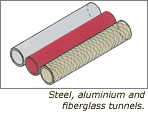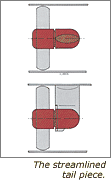|
Selecting
the correct bow thruster | Considerations
| One
or two propellers? | Installation
|

|
Points
to consider in selecting the correct Bow Thruster
It is the thrust of a bow propeller, not the capacity
of its electric motor (in kW or hp), which determines
its effectiveness. This thrust is the result of the following
combined factors: capacity of the electric motor, the
propeller (shape, dimensions and number of revolutions)
and the efficiency losses in the tunnel. VETUS bow thrusters
ensure a thrust of 33 to 40 lbf per kW of the electric
motor. Contrary to this, other bow thrusters have been
introduced on the market with an effective thrust of no
more than 9 lbf per kW! |
- The
Propeller
VETUS applies plastic propellers, which cannot
corrode. Due to their low weight, the maximum thrust
force is obtained very quickly and with minimum use
of energy. The propeller blades are shaped in such
a way, that the thrust is equal to both sides. They
are also designed with a special view to being used
inside a tunnel, thus avoiding cavitation(=unwanted
noise!).
-
 The Tunnel The Tunnel
The smaller the diameter of the tunnel, the
less resistance it will cause to the boat when under
way. Moreover, a smaller diameter also allows for
a more forward installation into the bow, which enhances
the turning moment of the boat. VETUS has obtained
the optimum compromise between high efficiency of
the bow thruster and little resistance when the boat
is under way. For vessels made of steel, aluminum
and fiberglass VETUS offers steel, aluminum or fiberglass
tunnels.
-
 The Tailpiece The Tailpiece
Application of a streamlined tailpiece by VETUS
not only ensures a better efficiency through lesser
resistance but also a lower noise level. Disturbance
of the free flow of water through the tunnel, caused
by a non- streamlined tailpiece, results in cavitation
or, again, unwanted noise! In order to protect the
bronze tailpiece against corrosion by electrolysis,
a zinc anode is standard supply with each VETUS bow
thruster. The transmission gear inside the tailpiece
consists of cogwheels, which produce far less noise
than chain transmission.
- The
Electric Motor
In order to ensure the highest possible efficiency,
in conjunction with an optimum lifespan, VETUS have
solely specified electric motors, which are built
to Suit the special purpose of being used as bow thruster
motors. Contrary to modified starter motors, the VETUS
motors allow for continuous running 'at full throttle'
during several minutes.
-
 Installation Possibilities Installation Possibilities
The motor of the VETUS bow thruster may be
installed in any position i.e. horizontally as well
as vertically. The motor is positioned above the propeller
at
all times.
What
factors will affect the thrust efficiency?
The nominal thrust force can only be obtained
under optimum conditions and the following factors will
influence the efficiency in a negative sense:
- Low
voltage of the power supply to the motor, due to a
too low battery
voltage or a too large a voltage drop through the
battery (main supply) cables.
- When
the actual tunnel/hull connection is not executed
in the best possible way; in other words: the shape
of the tunnel openings is a discerning factor.
- When
the tunnel openings are provided with grids; also
the shape of the grids may cause another reduction
of efficiency.
|
![]() |
Selecting
the correct bow thruster | Considerations
| One
or two propellers? | Installation
Copyright
© 2004 Joe Molinaro's East Coast Bow Thrusters; technical information
and graphics copyright © 2004
|


